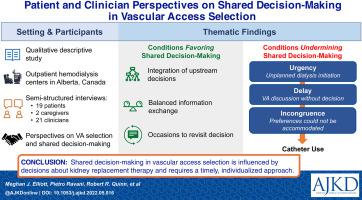American Journal of Kidney Diseases ( IF 9.4 ) Pub Date : 2022-07-20 , DOI: 10.1053/j.ajkd.2022.05.016 Meghan J Elliott 1 , Pietro Ravani 1 , Robert R Quinn 1 , Matthew J Oliver 2 , Shannan Love 3 , Jennifer MacRae 3 , Swapnil Hiremath 4 , Sarah Friesen 3 , Matthew T James 1 , Kathryn M King-Shier 5

|
Rationale & Objective
Collaborative approaches to vascular access selection are being increasingly encouraged to elicit patients’ preferences and priorities where no unequivocally superior choice exists. We explored how patients, their caregivers, and clinicians integrate principles of shared decision making when engaging in vascular access discussions.
Study Design
Qualitative description.
Setting & Participants
Semistructured interviews with a purposive sample of patients, their caregivers, and clinicians from outpatient hemodialysis programs in Alberta, Canada.
Analytical Approach
We used a thematic analysis approach to inductively code transcripts and generate themes to capture key concepts related to vascular access shared decision making across participant roles.
Results
42 individuals (19 patients, 2 caregivers, 21 clinicians) participated in this study. Participants identified how access-related decisions follow a series of major decisions about kidney replacement therapy and care goals that influence vascular access preferences and choice. Vascular access shared decision making was strengthened through integration of vascular access selection with dialysis-related decisions and timely, tailored, and balanced exchange of information between patients and their care team. Participants described how opportunities to revisit the vascular access decision before and after dialysis initiation helped prepare patients for their access and encouraged ongoing alignment between patients’ care priorities and treatment plans. Where shared decision making was undermined, hemodialysis via a catheter ensued as the most readily available vascular access option.
Limitations
Our study was limited to patients and clinicians from hemodialysis care settings and included few caregiver participants.
Conclusions
Findings suggest that earlier, or upstream, decisions about kidney replacement therapies influence how and when vascular access decisions are made. Repeated vascular access discussions that are integrated with other higher-level decisions are needed to promote vascular access shared decision making and preparedness.











































 京公网安备 11010802027423号
京公网安备 11010802027423号